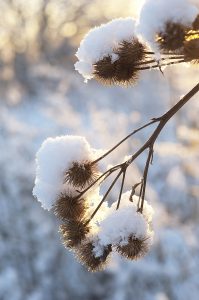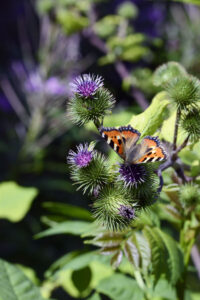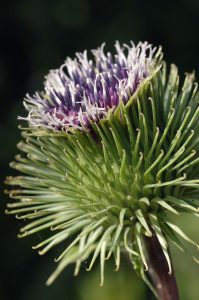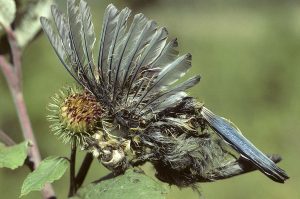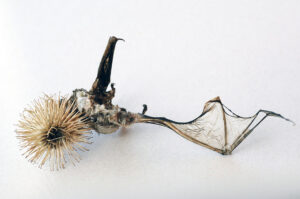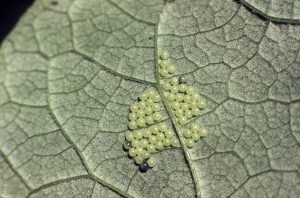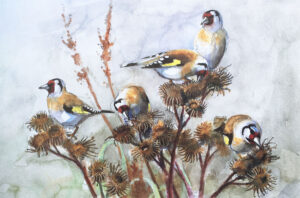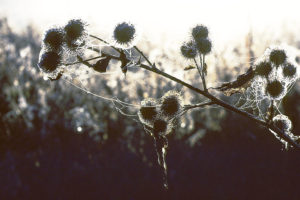Armed seeds
Seed heads of great burdock, weighed down by snow. (Photo copyright © by Kaj Halberg)
Kaj Halberg
The stately great burdock (Arctium lappa) is biennial. The first year, it displays a rosette of dark green leaves and is not very imposing, but the following year, a vigorous stem shoots into the air, and umbrellas of large, rhubarb-like leaves spread out in all directions. On the underside of the leaves, you sometimes encounter batches of eggs, laid by the great tiger moth (Arctia caja).
The stem is divided into several branches, and at the end of these are many flowerheads with lovely, reddish-violet flowers, which attract numerous hoverflies, bumblebees, and butterflies. Each of the flowerheads is surrounded by an armour of hooked spines. When the seeds are ripe, the entire flowerhead is easily detached, for instance when the pelt of a fox or a woollen sweater brushes against the hooks.
Even when the plant is flowering, these hooks are nasty, and woe the small bird or bat whose wing gets stuck on the hooks. They will face a slow death, unless a predator passes by.
In his delightful book All about Weeds, American botanist Edwin Spencer (1881-1964) writes about the burs: “Sometimes (a boy) is mean enough to throw a bunch of the burs into the hair of a rival, or even into the hair of the girl he thinks has snubbed him. She who has had this experience needs no technical description of the burdock.”
Great burdock has beautiful, reddish-violet flowerheads, which are much visited by butterflies. A small tortoiseshell (Aglais urticae) is seen in the upper picture. (Photos copyright © by Kaj Halberg)
Along the edge of the burdock flowerheads are numerous hooked prickles. One wing of this blue tit (Cyanistes caeruleus) got stuck in these hooks, causing the death of the bird. (Photos copyright © by Kaj Halberg)
Here, a wing of a common pipistrelle (Pipistrellus sp.) has been caught in the hooks. (Photo copyright © by Kaj Halberg)
Egg batch of great tiger moth (Arctia caja), placed on the underside of a burdock leaf. (Photo copyright © by Kaj Halberg)
In winter
In October and November, goldfinches (Carduelis carduelis) often visit the burdocks near the farm house on Vorsø, where they tuck into the large, oil-rich seeds. The fledged young are still begging food from their parents, although they are now old enough to find their own food. At times, up to 30 goldfinches can be seen in the burdocks simultaneously.
In winter, the dry, rattling burdock stems stick out of the snow. The winter storms tear at them, causing the remaining seed heads to loosen, fall to the ground, and blow across the snowy expanse. Finally, the stems topple due to the pressure of snow and moisture, and a period of time will come without the company of the stately burdock.
Seeds of the great burdock are a popular food item of the goldfinch. (Drawing copyright © by Jens Gregersen)
Seed heads with spiders’ webs and dew drops, photographed on a dark October morning. (Photo copyright © by Kaj Halberg)
Names of burdock
The generic name is derived from the Greek arktos (‘bear’), in allusion to the burs, which are somewhat similar to bear claws. Of course, the name burdock also refers to the burs, dock being a term applied to various plants with large leaves. And burdock leaves are large, growing up to 70 cm long and almost as wide.
One authority states that the specific name stems from the Celtic word llap (‘hand’), alluding to the ‘gripping’ burs. The popular name herrif is derived from two Anglo-Saxon words, haeg (‘hedge’), and reafe (‘robber’), perhaps referring to the vigorous growth of this species. Other folk names include fox’s clote, thorny bur, clot-bur, beggar’s buttons, and cockle buttons.
The role of great burdock in folklore and medicine is described on the page Plants: Plants in folklore and poetry.
(Uploaded February 2017)
(Latest update October 2023)
